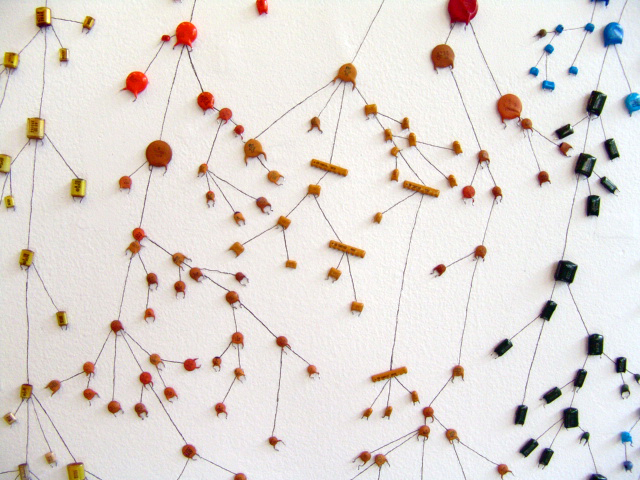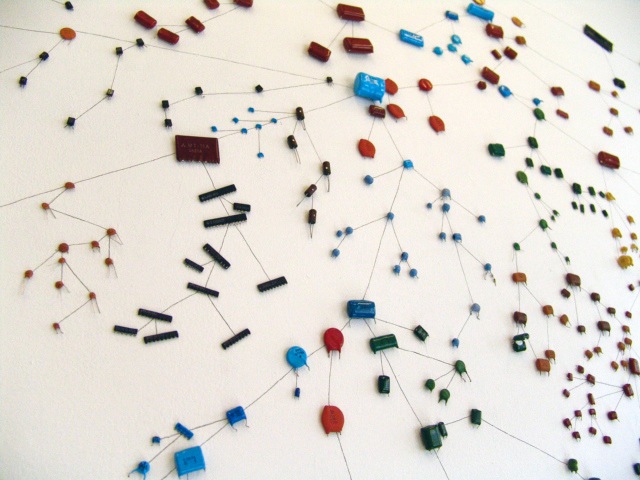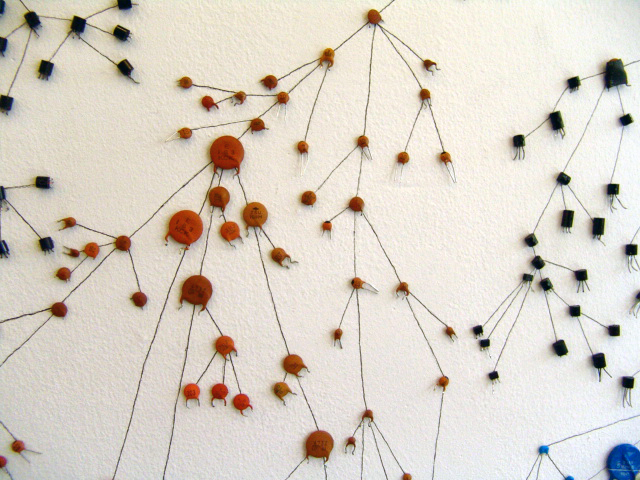





















Salvaged electronic components, ink, hot glue on wall
Approximately 10’x8′
2007

Until the Sun Goes Supernova is a sculptural wall drawing based on a phylogenetic tree: a branching diagram used in the sciences for visualizing relationships between entities. In biology, it can represent these relationships on multiple levels—at the level of the kingdom, the species, or the gene—and can encompass varying lengths of biological time. This artwork mapped relationships between individual components pulled from old electronics. The components were primarily capacitors, but included LEDs and other miscellany found in obsolete technology. I spent six months gathering discarded VCRs, record players, computer towers, and other apparatuses, dragging them back to my studio, and snipping each individual component from its circuit board. I then sorted each piece by type (resistor, capacitor, LED, magnet, etc.) and sub-type (shape/form, colour scheme, surface finish, possible degrees and kinds of damage, etc.).
Through the repetitive, monotonous labour of cutting leads free from their circuit boards, I became intimately acquainted with the aesthetic beauty of these tiny pieces of which I’d been entirely ignorant. The capacitors in particular had a kind of biological quality to them, with their terminals resembling “legs” and the many diverse colours and forms making up their “bodies.” They reminded me of imaginary creatures, drawn characters, of microscopic images of eukaryotic organisms.
The tree came together as a diagram of the evolutionary relatedness between the capacitors. I made up genetic “rules,” deciding which traits were dominant and which recessive (e.g. one shape or colour taking over from another), leaving room for mutation, sexual selection, and genetic drift. Some of the capacitors were missing “legs,” or were conjoined, chipped, discoloured, or covered in glue. Often these were left at the end of a “branch,” the last of their line, although sometimes they appeared at a node, or intersection, and went on to influence that lineage through to its end.
I’m interested in how our desire (and the desire foisted upon us by the forces of consumer capitalism, insofar as they can be separated) for smaller, more portable, wireless devices has merely displaced the bulky older technologies from our consciousness, while the physicality of these objects remains as solid as ever. The North American solution to the problem of e-waste is to ship it back to its country of “origin,” typically China, where, to recover valuable metals, it is burned or pounded into toxic dust. Until the Sun Goes Supernova is a symbolic gesture towards interrupting this cycle of production, and, by representing electronic components using a rubric that indicates organic life, tries to complicate our relationship to the products of consumer culture.
